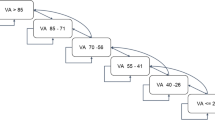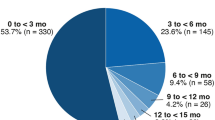Abstract
Aims
To provide 2-year follow-up data on eyes with diabetic macular edema (DME) that were non-responsive after three initial anti-vascular endothelial growth factor (VEGF) injections, comparing functional and anatomical outcomes under continued anti-VEGF therapy versus dexamethasone (DEX) implant.
Methods
Multicenter, retrospective chart review comparing eyes with treatment-naïve DME and a suboptimal response to a loading phase of anti-VEGF therapy (3 injections given monthly) which were then treated with (a) further anti-VEGF (n = 72) or (b) initially switched to DEX implant (n = 38). Main outcome measures were change in visual acuity (VA) and central subfield thickness (CST) from the end of the loading phase to 24 months.
Results
In 79% of the 12-month study population (87/110 eyes), 24-month data were available. One quarter of eyes in each group switched treatments during the second year. Eyes that were switched early to DEX implant maintained the functional and anatomical improvements at 24 months which were seen in the first year (from month 3: + 8.9 letters, − 214 µm). Eyes that were switched from anti-VEGF therapy to steroids in the second year improved VA and reduced CST at 24 months (from month 12: + 6.8 letters, p = 0.023; − 226 µm, p = 0.004). In eyes continued on anti-VEGF therapy, VA and CST were stable at 24 months (from month 3: + 2.8 letters, p = 0.254; − 24 µm, p = 0.243). Eyes that were non-responsive to anti-VEGF therapy for 12 months had similar chances to experience a VA gain from further therapy as eyes that were non-responsive for 3 months only (23.8 vs. 31.0%, p = 0.344).
Conclusions
The beneficial effect of an early switch to DEX implant in DME non-responders seen at month 12 was maintained during the second year. A later switch from anti-VEGF to steroids still provided significant improvement. Eyes continued on anti-VEGF over a period of 24 months maintained vision. A quarter of eyes, which had not improved vision at 12 months, exhibited a delayed response to treatment.


Similar content being viewed by others
References
Cho NH, Shaw JE, Karuranga S, Huang Y, da Rocha Fernandes JD, Ohlrogge AW et al (2018) IDF Diabetes Atlas: global estimates of diabetes prevalence for 2017 and projections for 2045. Diabetes Res Clin Pract 138:271–281
Yau JW, Rogers SL, Kawasaki R, Lamoureux EL, Kowalski JW, Bek T et al (2012) Global prevalence and major risk factors of diabetic retinopathy. Diabetes Care 35(3):556–564
Schmidt-Erfurth U, Garcia-Arumi J, Bandello F, Berg K, Chakravarthy U, Gerendas BS et al. (2017) Guidelines for the management of diabetic macular edema by the European Society of Retina Specialists (EURETINA). Ophthalmologica 237(4):185–222. https://doi.org/10.1159/000458539
Gonzalez VH, Campbell J, Holekamp NM, Kiss S, Loewenstein A, Augustin AJ et al (2016) Early and long-term responses to anti-vascular endothelial growth factor therapy in diabetic macular edema: analysis of protocol I Data. Am J Ophthalmol 172:72–79
Bressler NM, Beaulieu WT, Maguire MG, Glassman AR, Blinder KJ, Bressler SB et al (2018) Early response to anti-vascular endothelial growth factor and two-year outcomes among eyes with diabetic macular edema in protocol T. Am J Ophthalmol 195:93–100
Santos AR, Costa MA, Schwartz C, Alves D, Figueira J, Silva R et al (2018) Optical coherence tomography baseline predictors for initial best-corrected visual acuity response to intravitreal anti-vascular endothelial growth factor treatment in eyes with diabetic macular edema: the chartres study. Retina. 38(6):1110–1119
Maggio E, Sartore M, Attanasio M, Maraone G, Guerriero M, Polito A et al (2018) Anti-vascular endothelial growth factor treatment for diabetic macular edema in a real-world clinical setting. Am J Ophthalmol 195:209–222 PubMed PMID: 30098350
Boyer DS, Yoon YH, Belfort R Jr, Bandello F, Maturi RK, Augustin AJ et al (2014) Three-year, randomized, sham-controlled trial of dexamethasone intravitreal implant in patients with diabetic macular edema. Ophthalmology 121(10):1904–1914
Iglicki M, Busch C, Zur D, Okada M, Mariussi M, Chhablani JK, et al. (2018) Dexamethasone implant for diabetic macular edema in naive compared with refractory eyes: The International Retina Group real-life 24-month multicenter study. The IRGREL-DEX study. Retina 39(1), pp. 44–51. https://doi.org/10.1097/IAE.0000000000002196
Malcles A, Dot C, Voirin N, Agard E, Vie AL, Bellocq D et al (2017) Real-life study in diabetic macular edema treated with dexamethasone implant: the reldex study. Retina. 37(4):753–760
Busch C, Zur D, Fraser-Bell S, Lains I, Santos AR, Lupidi M et al (2018) Shall we stay, or shall we switch? Continued anti-VEGF therapy versus early switch to dexamethasone implant in refractory diabetic macular edema. Acta Diabetol 55(8):789–796
Bressler SB, Qin H, Beck RW, Chalam KV, Kim JE, Melia M et al (2012) Factors associated with changes in visual acuity and central subfield thickness at 1 year after treatment for diabetic macular edema with ranibizumab. Archives of ophthalmology. 130(9):1153–1161
Hajian-Tilaki K (2013) Receiver operating characteristic (ROC) curve analysis for medical diagnostic test evaluation. Casp J Intern Med. 4(2):627–635
Wells JA, Glassman AR, Ayala AR, Jampol LM, Bressler NM, Bressler SB et al (2016) Aflibercept, bevacizumab, or ranibizumab for diabetic macular edema: two-year results from a comparative effectiveness randomized clinical trial. Ophthalmology. 123(6):1351–1359
Elman MJ, Bressler NM, Qin H, Beck RW, Ferris FL, Friedman SM et al (2011) Expanded 2-year follow-up of ranibizumab plus prompt or deferred laser or triamcinolone plus prompt laser for diabetic macular edema. Ophthalmology. 118(4):609–614
Gao X, Obeid A, Aderman CM, Talcott KE, Ali FS, Adam MK et al (2019) Loss to follow-up after intravitreal anti-vascular endothelial growth factor injections in patients with diabetic macular edema. Ophthalmol Retina. 3(3):230–236
Ziemssen F, Wachtlin J, Kuehlewein L, Gamulescu MA, Bertelmann T, Feucht N et al (2018) Intravitreal ranibizumab therapy for diabetic macular edema in routine practice: two-year real-life data from a non-interventional, multicenter study in Germany. Diabetes Ther. 9(6):2271–2289
Author information
Authors and Affiliations
Consortia
Corresponding author
Ethics declarations
Conflict of interest
The authors declare that they have no conflict of interest.
Ethical approval
The study was approved by the individual institutional review board of the participating centers.
Informed consent
None.
Additional information
Managed By Giuseppe Querques.
Publisher's Note
Springer Nature remains neutral with regard to jurisdictional claims in published maps and institutional affiliations.
Electronic supplementary material
Below is the link to the electronic supplementary material.
Rights and permissions
About this article
Cite this article
Busch, C., Fraser-Bell, S., Iglicki, M. et al. Real-world outcomes of non-responding diabetic macular edema treated with continued anti-VEGF therapy versus early switch to dexamethasone implant: 2-year results. Acta Diabetol 56, 1341–1350 (2019). https://doi.org/10.1007/s00592-019-01416-4
Received:
Accepted:
Published:
Issue Date:
DOI: https://doi.org/10.1007/s00592-019-01416-4




